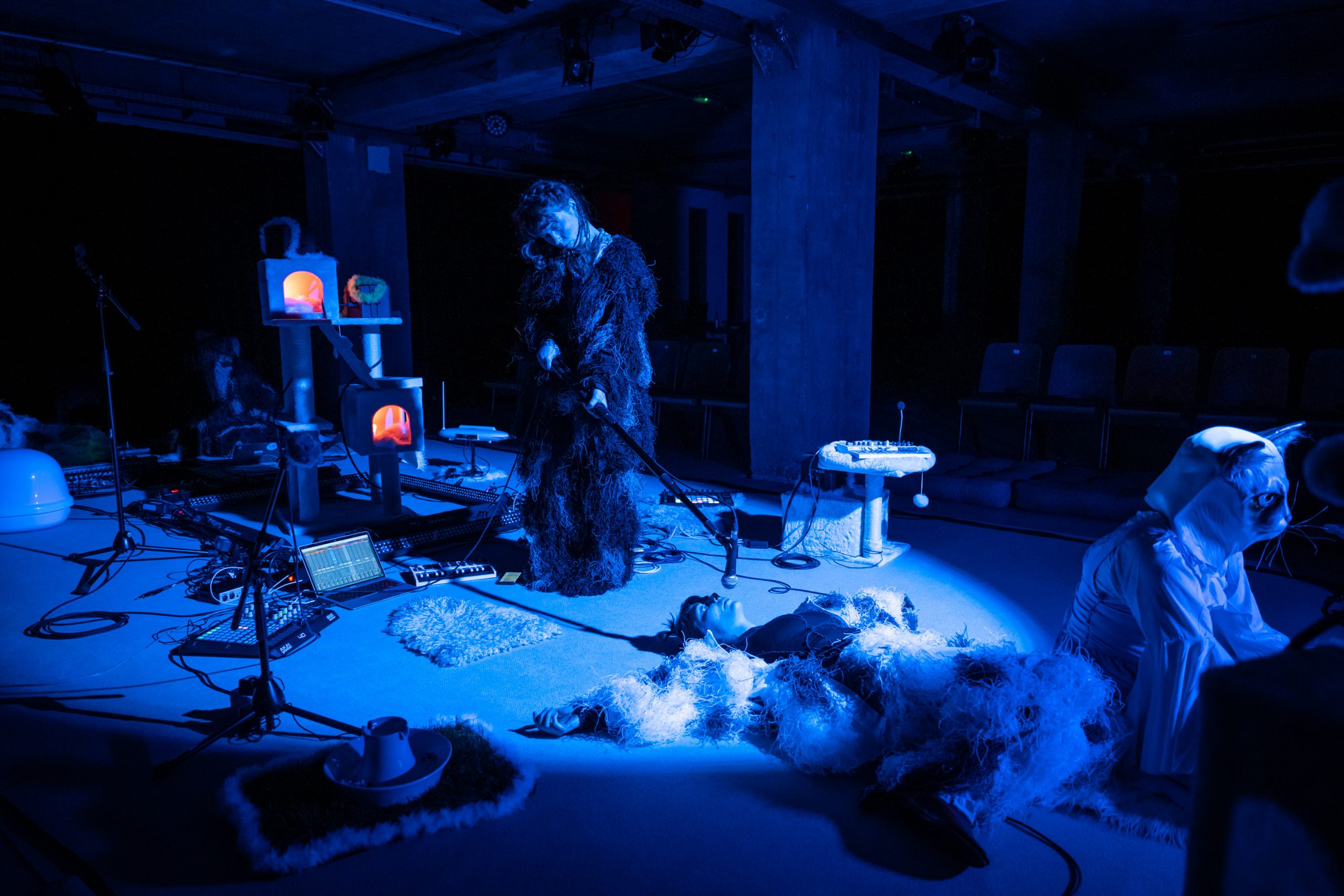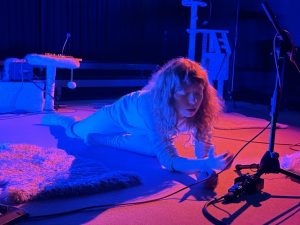ANTONIA ALESSIA VIRGINIA BEESKOW: SONIC TOUCH
ZUIHITSU
QUIRKY THOUGHTS COLLECTION
Essays, personal stories and curiosities from our guest fem人le contributors
ANTONIA ALESSIA VIRGINIA BEESKOW: SONIC TOUCH
The sonic touch of frequencies – On cat’s purring
When I was a newborn, I suffered from cat hair allergy. Unfortunately, the doctors missed to discover the illness in the beginning.
At home my family had a beautiful Persian cat and I still feel like even remembering this creature, a whizzing shadow in my most unaware dreams. Every now and then, my dad rushed with me in his arm to the hospital because I sometimes couldn’t breathe at home until the problem was found: the long and opulent cat’s hair.
When I was a child, I always wanted to pet a cat, but I was not allowed. I was so desperate about this wish, as they also made this bass sound when touching and caressing them.
You may guess it, this story will go happy ending and yes, one day when I was staying at my grandparents’ house during Easter vacation, the allergy stopped. The neighbours had kittens stumbling everywhere around in the garden and finally I could hold a small black cat in my arms. She appeared light, also clamping with the small claws into my anorak’s cloth, leaving tiny holes in the blue fabric. I think I was six years old at that time and I can still remember this embrace very clearly. Also because there was a kind of loud noise emerging from the rather little body, the purring sound, there it was! I like that memories may contain images, movements but also sounds, as if there was a small film reel rolling on your mind.
Recently, I was hanging out with a friend, scrolling through Wikipedia articles and suddenly we found the purring sounds’ page. It says that the noise still seems mysterious and scientists think that cats have a neural oscillator inside their heads generating this deep bass sound.
Think of Aristocats’ Jazz cats band, T.S. Eliot’s Old Possum’s Book of Practical Cats and the musical inspired by this; somehow there must be a subtle connection of music and cats.
In the short film „Chat écoutant la musique“ (1988), Chris Marker pays homage to his beloved cat Guillaume-en-Egypte, sleeping on a Yamaha DX7, love this video.
Purrrr-rrrr, rrr, rrrr, it’s nice that the sound matches the word in an onomatopoetic sense. In German „to purr“ means „schnurren“, matching the sonic quality in the same way. In those classic fairytales there are some very popular cat protagonists, such as to Puss in Boots and Kater Murr. And in 19th century German dialect, they also used the word „spinnen“ instead of „schnurren“, because it seemed equal to the sound of a spinning wheel when spinning wool.
You might have also heard of the Yōkai, spirits from Japanese folklore, and you’ll find some characters like the bakeneko, monster cats, that dance or even play instruments, e.g. Okesa neko, a former bakeneko cat, who transformed herself into a geisha entertaining people with singing and dancing in order to repay the kindness her former owner showed her.
These lines of thought are not fundamental on a scientific level, but still, it is also interesting that the sound stays mysterious in a way. On the other hand, it is a very cultivated, natural sound, like cow bells or the kikeriki of a cock on a farm. But purring has more of a textural quality about itself, dense and thick and warm, as if you could take a bath inside. Purring is a stretched out sonic sequence, enduring, and you have to get closer to really get the whole spectrum, so I think you associate somehow nearness — and also because if you pet the cat, they sometimes start immediately.
While I am writing this article, I look at my own cat, Nele. She is lying on the carpet and stretches herself in a lazy and satisfied way. Next to their predatory habits, the quality you may appreciate about cats a lot is their undying, à la „I couldn’t care less“, never ending laziness. How can one be so chilled?
From a sound artist standpoint, I am also thrilled about this noise, as technical devices like amplifiers, loudspeakers, or if you record electromagnetic frequencies, will share this sound quality too. Think of those test noises, e.g. pink noise, making you feel relaxed — this simple trick of nowaday’s parents to play pink noise sound to their babies to calm. But there is also the sound of the speakers themselves, and sometimes I really enjoy just listening to their own signals sitting in a studio, it’s their presence, I guess. But cat sounds are natural (in a way), they purr in an irregular way, the sound follows their breathing rhythm, stopping shortly to swallow. I read about the purpose of purring, and its frequency range is 25 to 150 Hertz, deep bass sound. It is said, that these frequencies are used for stress relief and bone healing. If you go on YouTube, you will find lots of videos, dealing with this topic of sound healing, bone healing, etc. and you will also find some videos of small or cute kittens purring being recorded with a binaural microphone.

Sailor Tune: schroedinger’s cats. photo: Christian Knieps
With my performance collective, Sailor Tune, we also created a piece last year, dealing with cats on the internet and this scientific experiment of Schroedinger’s cat — you know, this cat which is alive and dead at the same time, as long as you do not observe the experiment, find the proof, one of the major experiments in quantum physics or at least the most popular one, I guess. There is one sequence in which we reach out to the „cat state“, which shall combine the qualities of being thus and that, at the same time, everywhere, all at once. There is an AI generated voice of my own guiding you into the cat state, but in the background you will hear a soundscape of different purring sounds, equalized, pitched, sampled and in a 7.1 surround panning.
Following this link you can see a short reel of the piece ‘schroedinger’s cats’.
Nele is listening to an excerpt from Christina Kubisch’s „The Cat’s Dream“
My cat Nele helpes out a lot with her voice for me, for scores, installations and radio plays. In my latest piece, a commission work for Radiophrenia festival 2023 at Glasgow, there is also a replique, in which you can listen to her, as a musical score develops deriving from the rhythm she creates.
Nele also enjoys being close to me while I am creating sounds and atmospheres for sound pieces and performances. My cat and I, we were recently listening to a piece by Christina Kubisch, „The Cat’s Dream“. Of course, I am not completely sure if both of us were listening. But still, I always enjoy when artists use this sound to immerse or guide you in a sphere, which seems familiar and still, you don’t really grasp it. It is just so wide angled. Another piece I really like, is „Tiger Balm“ by Annea Lockwood. I listen to it every now and then, as she combines this relaxing sound with rather uncomfortable noises, but still this purring sound in the beginning stays very present.
In the end, what really is a beautiful thought to me: cats have this strange, secret noise sound skill and they share it with us, so it’s a true animal-human relationship on a sonic level.

Antonia Alessia Virginia Beeskow, born in Düsseldorf, studied archeology, Angewandte Theaterwissenschaft and Klang & Realität.
As artist, sound designer and performer, Beeskow works in the independent scene, radio plays, podcasts, installations, experimental films and in the theater in different collaborations and writes about female* composers and sound artists for the grapefruits.online fanzine.

